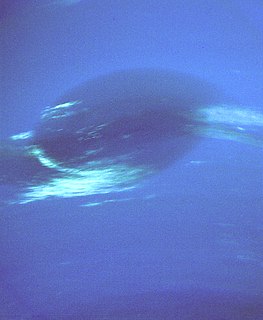Related Research Articles

Dark matter is believed to be a form of matter thought to account for approximately 85% of the matter in the universe and about 27% of its total mass–energy density or about 2.241×10−27 kg/m3. Its presence is implied in a variety of astrophysical observations, including gravitational effects that cannot be explained by accepted theories of gravity unless more matter is present than can be seen. For this reason, most experts think that dark matter is abundant in the universe and that it has had a strong influence on its structure and evolution. Dark matter is called dark because it does not appear to interact with the electromagnetic field, which means it does not absorb, reflect or emit electromagnetic radiation, and is therefore difficult to detect.

In cosmology, the cosmological constant, alternatively called Einstein's cosmological constant, is the energy density of space, or vacuum energy, that arises in Albert Einstein's field equations of general relativity. It is closely associated to the concept of dark energy.

Observations show that the expansion of the universe is accelerating, such that the velocity at which a distant galaxy recedes from the observer is continuously increasing with time.

The Standard Model of particle physics is the theory describing three of the four known fundamental forces in the universe, as well as classifying all known elementary particles. It was developed in stages throughout the latter half of the 20th century, through the work of many scientists around the world, with the current formulation being finalized in the mid-1970s upon experimental confirmation of the existence of quarks. Since then, confirmation of the top quark (1995), the tau neutrino (2000), and the Higgs boson (2012) have added further credence to the Standard Model. In addition, the Standard Model has predicted various properties of weak neutral currents and the W and Z bosons with great accuracy.

In Ancient Chinese philosophy, yin and yang is a concept of dualism, describing how seemingly opposite or contrary forces may actually be complementary, interconnected, and interdependent in the natural world, and how they may give rise to each other as they interrelate to one another. In Chinese cosmology, the universe creates itself out of a primary chaos of material energy, organized into the cycles of Yin and Yang and formed into objects and lives. Yin is the receptive and Yang the active principle, seen in all forms of change and difference such as the annual cycle, the landscape, sexual coupling, the formation of both men and women as characters and sociopolitical history.

The Great Dark Spot was one of a series of dark spots on Neptune similar in appearance to Jupiter's Great Red Spot. In 1989, GDS-89 was the first Great Dark Spot on Neptune to be observed by NASA's Voyager 2 spaceprobe. Like Jupiter's spot, Great Dark Spots are anticyclonic storms. However, their interiors are relatively cloud-free, and unlike Jupiter's spot, which has lasted for hundreds of years, their lifetimes appear to be shorter, forming and dissipating once every few years or so. Based on observations taken with Voyager 2 and since then with the Hubble Space Telescope, Neptune appears to spend somewhat more than half its time with a Great Dark Spot.

A light characteristic is a graphic and text description of a navigational light sequence or colour displayed on a nautical chart or in a Light List with the chart symbol for a lighthouse, lightvessel, buoy or sea mark with a light on it. The graphic indicates how the real light may be identified when looking at its actual light output type or sequence. Different lights use different colours, frequencies and light patterns, so mariners can identify which light they are seeing.

In analytical psychology, the shadow is either an unconscious aspect of the personality that the conscious ego does not identify in itself, or the entirety of the unconscious, i.e., everything of which a person is not fully conscious. In short, the shadow is the unknown side.
Dark ambient is a genre of post-industrial music that features an ominous, dark droning and often gloomy, monumental or catacombal atmosphere, partially with discordant overtones. It shows similarities toward ambient music, a genre that has been cited as a main influence by many dark ambient artists, both conceptually and compositionally. Although mostly electronically generated, dark ambient also includes the sampling of hand-played instruments and semi-acoustic recording procedures, and is strongly related to ritual industrial music.

The ΛCDM or Lambda-CDM model is a parameterization of the Big Bang cosmological model in which the universe contains three major components: first, a cosmological constant denoted by Lambda and associated with dark energy; second, the postulated cold dark matter ; and third, ordinary matter. It is frequently referred to as the standard model of Big Bang cosmology because it is the simplest model that provides a reasonably good account of the following properties of the cosmos:
The spark spread is the theoretical gross margin of a gas-fired power plant from selling a unit of electricity, having bought the fuel required to produce this unit of electricity. All other costs must be covered from the spark spread. The term was first coined by Tony West's trading team on the trading floor of National Power Ltd in Swindon, UK during the late 1990s and quickly came into common usage as other traders realised the trading and hedging opportunities.

According to modern models of physical cosmology, a dark matter halo is a basic unit of cosmological structure. It is a hypothetical region that has decoupled from cosmic expansion and contains gravitationally bound matter. A single dark matter halo may contain multiple virialized clumps of dark matter bound together by gravity, known as subhalos. Modern cosmological models, such as ΛCDM, propose that dark matter halos and subhalos may contain galaxies. The dark matter halo of a galaxy envelops the galactic disc and extends well beyond the edge of the visible galaxy. Thought to consist of dark matter, halos have not been observed directly. Their existence is inferred through observations of their effects on the motions of stars and gas in galaxies and gravitational lensing. Dark matter halos play a key role in current models of galaxy formation and evolution. Theories that attempt to explain the nature of dark matter halos with varying degrees of success include Cold Dark Matter (CDM), Warm Dark Matter, and massive compact halo objects (MACHOs).
Velarization is a secondary articulation of consonants by which the back of the tongue is raised toward the velum during the articulation of the consonant. In the International Phonetic Alphabet, velarization is transcribed by one of four diacritics:

GOOD Music is an American record label founded by rapper Kanye West in 2004. The label signed an exclusive long-term worldwide label agreement with The Island Def Jam Music Group in 2011. In 2012, the label released its debut compilation album Cruel Summer. In 2015, Pusha T was appointed the president of the label by West, while record executive Steven Victor was appointed COO.

Dark Romanticism is a literary subgenre of Romanticism, reflecting popular fascination with the irrational, the demonic and the grotesque. Often conflated with Gothicism, it has shadowed the euphoric Romantic movement ever since its 18th-century beginnings. Edgar Allan Poe is often celebrated as one of the supreme exponents of the tradition.

In physical cosmology and astronomy, dark energy is an unknown form of energy that affects the universe on the largest scales. The first observational evidence for its existence came from measurements of supernovae, which showed that the universe does not expand at a constant rate; rather, the expansion of the universe is accelerating. Understanding the evolution of the universe requires knowledge of its starting conditions and its composition. Prior to these observations, the only forms of matter–energy known to exist were ordinary matter, antimatter, dark matter, and radiation. Measurements of the cosmic microwave background suggest the universe began in a hot Big Bang, from which general relativity explains its evolution and the subsequent large-scale motion. Without introducing a new form of energy, there was no way to explain how an accelerating universe could be measured. Since the 1990s, dark energy has been the most accepted premise to account for the accelerated expansion. As of 2021, there are active areas of cosmology research aimed at understanding the fundamental nature of dark energy.

Fesenkov Crater is an impact crater in the Lunae Palus quadrangle of Mars. It is located at 21.8° N and 86.7° W. It was named after Vasilii G. Fesenkov, a Russian astrophysicist (1889–1972).

The dark photon is a hypothetical hidden sector particle, proposed as a force carrier similar to the photon of electromagnetism but potentially connected to dark matter. In a minimal scenario, this new force can be introduced by extending the gauge group of the Standard Model of Particle Physics with a new abelian U(1) gauge symmetry. The corresponding new spin-1 gauge boson can then couple very weakly to electrically charged particles through kinetic mixing with the ordinary photon and could thus be detected. The dark photon can also interact with the Standard Model if some of the fermions are charged under the new abelian group. The possible charging arrangements are restricted by a number of consistency requirements such as anomaly cancellation and constraints coming from Yukawa matrices.
Thoscora rubrivena is a moth of the family Megalopygidae. It was described by E. Dukinfield Jones in 1912. It is found in Brazil.
References
- ↑ Beccaloni, G.; Scoble, M.; Kitching, I.; Simonsen, T.; Robinson, G.; Pitkin, B.; Hine, A.; Lyal, C., eds. (2003). "Thoscora omayena". The Global Lepidoptera Names Index . Natural History Museum . Retrieved May 17, 2018.
- ↑ Transactions of the American Entomological Society